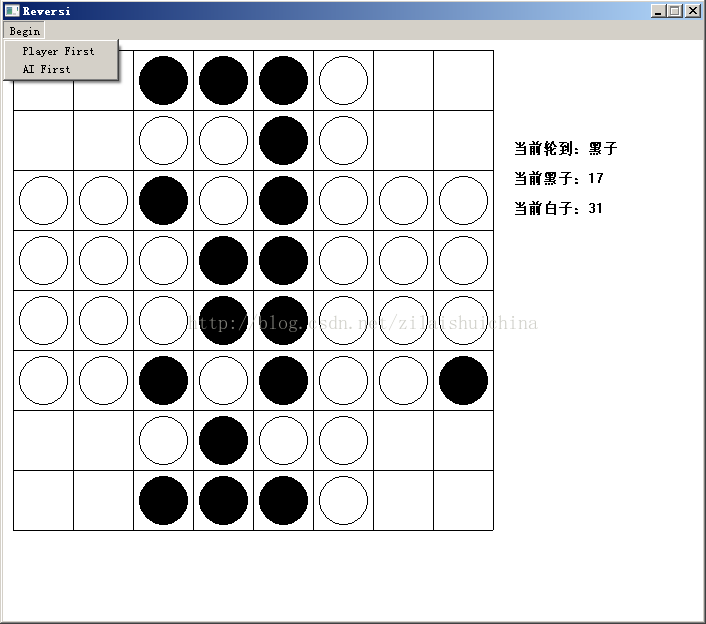本文主要是介绍游戏开发(三)——WIN32 黑白棋(一)——棋局逻辑的设计,希望对大家解决编程问题提供一定的参考价值,需要的开发者们随着小编来一起学习吧!
今天以黑白棋为例,开始给一个win32的小游戏设计,
分3部分介绍。
1、棋局的现实
2、AI的现实
3、游戏画面的现实
提供一下完整项目下载
其中第一部分为黑白棋游戏的主要逻辑:
1、棋盘,以及棋盘上的棋子的存储形式。这里用到了位图。
2、是否可以落子的判断(黑白棋是只有你落子的位置,在横竖斜八个方向中任意一个方向,能吃掉对方的子,你才可以落在该位置,八个方向都吃不掉对方子的位置是不能下的),以及吃子的逻辑(吃子的逻辑同样是八个方向,两个己方棋子之间夹住的对方棋子,可以被吃掉,翻转为己方棋子)。这里为了使得代码简介一点,使用了函数指针(不同方向上坐标的变化逻辑不一样)。
3、某一方下了一个子之后,交换手的判断(黑白棋中存在可能,一方下了一个子,并吃掉对方的子,之后对方无子可下,没有一个位置能使得对方能吃掉己方的棋子,所以黑白棋并不一定始终是一人一步来的,它可能存在一方连续落子的情况)。
4、游戏是否结束的判断(由于存在无子可下的情况,有可能双方都无子可以下,即一方将另一方全部吃光,所以黑白棋不一定是下满棋盘才分出胜负)。
第二部分主要为了写AI:
黑白棋的AI其实蛮复杂,有专门的研究黑白棋的AI的算法文章,这里只介绍一下,然后简单实现了一个AI,主要是最大最小算法,以及枝剪算法。
第三部分主要是游戏画面的显示:
涉及到windows消息机制,鼠标事件,键盘事件,菜单事件,定时器事件;以及简单的图形、文字绘制,涉及到画笔、画刷填充、绘图层HDC、画线、画圆、显示文字、双缓冲的位图拷贝。
阅读第三部分前,读者可以先行阅读《windows程序设计》一书打个基础。也可以看完博文之后,再将涉及到的图形API,消息机制等windows程序设计中涉及到的点带回到书中去详细了解。
黑白棋游戏在设计中需要注意的几点:
1、惯例,首先要定义好棋盘的坐标,定义为左上角那一格为(0,0),向右为x正方向,向下为y正方向,黑白棋棋盘是一个8*8的棋盘,所以定义两个常量表示:
const int REVERSI_MAX_ROW = 8;
const int REVERSI_MAX_COLUMN = 8;2、棋盘上棋子的类型分三种:黑子,白子,空白无子,枚举表示
enum EnumReversiPiecesType
{enum_ReversiPieces_Null = 0x00,enum_ReversiPieces_Black = 0x01,enum_ReversiPieces_White = 0x02,
};这三种情况,其实用2位2进制即可表示,一行8个位置就是16位2进制,就是一个WORD就足够了,所以:
3、棋盘的表示,位图
TArray1<WORD, REVERSI_MAX_ROW> m_Map;位图是8行,每行是一个WORD,这个TArray1是之前实现的 一维数组模板直接用的
4、棋盘上一个位置的设计,因为这里涉及到位置(即坐标)的八方向移动的逻辑,因此将坐标位置单独抽象出来,实现坐标的上下左右以及斜的四方向的坐标变化,然后将其重定义为函数指针,使得后面在坐标变化时,不用switch...case八种情况,而是可以将方向当成参数。
typedef void (ReversiPoint::*ReversiPointForward)();5、某一方的棋子,在某一坐标位置,向某一方向,是否可以吃掉对方的棋子的判断
bool ReversiCheck(EnumReversiPiecesType type, char row_y, char column_x, ReversiPointForward forward);定义一个坐标对象point,初值为当前点row_y, column_x
记录该方向上的搜索次数search,初值为0
point向forward方向移动
搜索次数search++
while (point是一个合法的坐标,不能移出棋盘外面去了)
{取point当前位置的棋子类型(此时已经是forward移动一次之后的位置了,不是row_y, column_x了)if (当前位置有棋子){if (当前位置的棋子类型等于传入参数type,type就是要下的棋子类型){if (搜索次数search大于1次){说明找到的同色棋子与当前棋子坐标差超过1,point至少移动了2次则两子之间夹有不同色的棋子符合翻转规则,return true}else{说明找到的同色棋子与当前棋子,两子是紧挨着的该方向两子之间无子可以翻转不符合翻转规则,return false}}else{说明找到的是不同色的棋子,继续向下一个位置搜point向forward方向移动搜索次数search++}}else{一直找到空位也没找到,该方向没有同色棋子,无法翻转}
}
超出棋盘范围都没有找到同色棋子,该方向没有同色棋子,无法翻转6、某一方的棋子,在某一坐标位置,向某一方向,吃掉对方的棋子
void DoReversi(EnumReversiPiecesType type, char row_y, char column_x, ReversiPointForward forward);伪代码实现
定义一个坐标对象point,初值为当前点row_y, column_x
point向forward方向移动
while (point是一个合法的坐标,不能移出棋盘外面去了)
{取point当前位置的棋子类型(此时已经是forward移动一次之后的位置了,不是row_y, column_x了)if (当前位置的棋子类型不等于传入参数type,type就是下的棋子类型){将该位置的棋子类型翻转为type一方的棋子point向forward方向移动因为在翻转之前做了ReversiCheck的判断即这个方向肯定是符合翻转规则,有子可吃的所以这里不再判断当前位置的棋子类型是否为空}
}有了上面两个基本函数
7、判断某个位置是否可以落子
bool ReversiCheck(EnumReversiPiecesType type, char row_y, char column_x);则是分别调用上面的ReversiCheck,然后forward传入不同的方向
8、判断某一方是否可以落子
bool CanPlay(EnumReversiPiecesType type);9、落一个子之后的吃子
void DoReversi(EnumReversiPiecesType type, char row_y, char column_x);则是分别调用上面的DoReversi,然后forward传入不同的方向
10、最后,判断游戏是否结束的逻辑,即双方都无子可下,则游戏结束
先给个游戏截图吧
下面先贴出第一部分的代码
ReversiCommon.h
#ifndef _ReversiCommon_h_
#define _ReversiCommon_h_#include <windows.h>//棋盘大小
const int REVERSI_MAX_ROW = 8;
const int REVERSI_MAX_COLUMN = 8;enum EnumReversiPiecesType
{enum_ReversiPieces_Null = 0x00,enum_ReversiPieces_Black = 0x01,enum_ReversiPieces_White = 0x02,
};EnumReversiPiecesType SwapType(EnumReversiPiecesType type);enum EnumReversiResult
{enum_Reversi_Playing = 0,enum_Reversi_Draw,enum_Reversi_Win_Black,enum_Reversi_Win_White,
};//权值表
const int g_Weight[REVERSI_MAX_ROW][REVERSI_MAX_COLUMN] = {{0x1 << 24, 0x1, 0x1 << 20, 0x1 << 16,0x1 << 16,0x1 << 20, 0x1, 0x1 << 24},{0x1, 0x1, 0x1 << 16, 0x1 << 4, 0x1 << 4, 0x1 << 16, 0x1, 0x1 },{0x1 << 20, 0x1 << 16, 0x1 << 12, 0x1 << 8, 0x1 << 8, 0x1 << 12, 0x1 << 16, 0x1 << 20},{0x1 << 16, 0x1 << 4, 0x1 << 8, 0, 0, 0x1 << 8, 0x1 << 4, 0x1 << 16},{0x1 << 16, 0x1 << 4, 0x1 << 8, 0, 0, 0x1 << 8, 0x1 << 4, 0x1 << 16},{0x1 << 20, 0x1 << 16, 0x1 << 12, 0x1 << 8, 0x1 << 8, 0x1 << 12, 0x1 << 16, 0x1 << 20},{0x1, 0x1, 0x1 << 16, 0x1 << 4, 0x1 << 4, 0x1 << 16, 0x1, 0x1 },{0x1 << 24, 0x1, 0x1 << 20, 0x1 << 16,0x1 << 16,0x1 << 20, 0x1, 0x1 << 24}
};//按权值表降序排列的坐标顺序表
const BYTE g_WeightOrder[REVERSI_MAX_ROW * REVERSI_MAX_COLUMN - 4][2] = {{ 0, 0}, { 0, 7}, { 7, 0}, { 7, 7},//0x01000000{ 0, 2}, { 0, 5}, { 2, 0}, { 2, 7},//0x00100000{ 7, 2}, { 7, 5}, { 5, 0}, { 5, 7},{ 0, 3}, { 0, 4}, { 1, 2}, { 1, 5},//0x00010000{ 2, 1}, { 2, 6}, { 3, 0}, { 3, 7},{ 4, 0}, { 4, 7}, { 5, 1}, { 5, 6},{ 6, 2}, { 6, 5}, { 7, 3}, { 7, 4},{ 2, 2}, { 2, 5}, { 5, 2}, { 5, 5},//0x00001000{ 2, 3}, { 2, 4}, { 3, 2}, { 3, 5},//0x00000100{ 4, 2}, { 4, 5}, { 5, 3}, { 5, 4},{ 1, 3}, { 1, 4}, { 3, 1}, { 3, 6},//0x00000010{ 4, 1}, { 4, 6}, { 6, 3}, { 6, 4},{ 0, 1}, { 0, 6}, { 1, 0}, { 1, 7},//0x00000001{ 6, 0}, { 6, 7}, { 7, 1}, { 7, 6},{ 1, 1}, { 1, 6}, { 6, 1}, { 6, 6} //0x00000001//{ 3, 3}, { 3, 4}, { 4, 3}, { 4, 4}, 初始4个位置不用判断
};#endifReversiCommon.cpp
#include "ReversiCommon.h"EnumReversiPiecesType SwapType(EnumReversiPiecesType type)
{if (enum_ReversiPieces_Black == type){return enum_ReversiPieces_White;}else if (enum_ReversiPieces_White == type){return enum_ReversiPieces_Black;}else{return enum_ReversiPieces_Null;}
}ReversiPoint.h
#ifndef _ReversiPoint_h_
#define _ReversiPoint_h_#include "ReversiCommon.h"typedef struct ReversiPoint
{char m_row_y;char m_column_x;ReversiPoint& operator= (const ReversiPoint& temp){m_row_y = temp.m_row_y;m_column_x = temp.m_column_x;return *this;}bool operator!= (const ReversiPoint& temp){if (m_row_y == temp.m_row_y &&m_column_x == temp.m_column_x){return false;}else{return true;}}bool IsValid(){if (0 <= m_row_y &&0 <= m_column_x &&m_row_y < REVERSI_MAX_ROW &&m_column_x < REVERSI_MAX_COLUMN){return true;}else{return false;}}void UL(){m_row_y--;m_column_x--;}void U(){m_row_y--;}void UR(){m_row_y--;m_column_x++;}void L(){m_column_x--;}void R(){m_column_x++;}void DL(){m_row_y++;m_column_x--;}void D(){m_row_y++;}void DR(){m_row_y++;m_column_x++;}
}ReversiPoint;typedef void (ReversiPoint::*ReversiPointForward)();#endifReversiBitBoard.h
#ifndef _ReversiBitBoard_h_
#define _ReversiBitBoard_h_#include <Windows.h>#include "TArray.h"#include "ReversiCommon.h"
#include "ReversiPoint.h"class ReversiBitBoard
{
public:ReversiBitBoard();~ReversiBitBoard();void Init();ReversiBitBoard& operator= (const ReversiBitBoard& temp);void SetPieces(EnumReversiPiecesType type, char row_y, char column_x);EnumReversiPiecesType GetPieces(char row_y, char column_x);EnumReversiResult IsGameOver();bool CanPlay(EnumReversiPiecesType type);bool CanPlay(EnumReversiPiecesType type, char row_y, char column_x);bool ReversiCheck(EnumReversiPiecesType type, char row_y, char column_x);void DoReversi(EnumReversiPiecesType type, char row_y, char column_x);int GetCount(EnumReversiPiecesType type);void SwapPlayer();EnumReversiPiecesType GetCurrType();private:void DoReversi(EnumReversiPiecesType type, char row_y, char column_x, ReversiPointForward forward);bool ReversiCheck(EnumReversiPiecesType type, char row_y, char column_x, ReversiPointForward forward);TArray1<WORD, REVERSI_MAX_ROW> m_Map;EnumReversiPiecesType m_CurrType;
};#endifReversiBitBoard.cpp
#include "ReversiBitBoard.h"ReversiBitBoard::ReversiBitBoard()
{}ReversiBitBoard::~ReversiBitBoard()
{}void ReversiBitBoard::Init()
{m_CurrType = enum_ReversiPieces_Black;//规定黑先for (int i = 0; i < REVERSI_MAX_ROW; i++){m_Map[i] = 0;}SetPieces(enum_ReversiPieces_White, 3, 3);SetPieces(enum_ReversiPieces_Black, 3, 4);SetPieces(enum_ReversiPieces_Black, 4, 3);SetPieces(enum_ReversiPieces_White, 4, 4);
}ReversiBitBoard& ReversiBitBoard::operator=(const ReversiBitBoard& temp)
{m_Map = temp.m_Map;m_CurrType = temp.m_CurrType;return *this;
}void ReversiBitBoard::SetPieces(EnumReversiPiecesType type, char row_y, char column_x)
{m_Map[row_y] = m_Map[row_y] & (~(0x0003 << (column_x * 2)));m_Map[row_y] = m_Map[row_y] | (type << (column_x * 2));
}EnumReversiPiecesType ReversiBitBoard::GetPieces(char row_y, char column_x)
{WORD value = m_Map[row_y] & (0x0003 << (column_x * 2));value = value >> (column_x * 2);EnumReversiPiecesType type = static_cast<EnumReversiPiecesType>(value);return type;
}int ReversiBitBoard::GetCount(EnumReversiPiecesType type)
{int count = 0;for (int i = 0; i < REVERSI_MAX_ROW; i++){for (int j = 0; j < REVERSI_MAX_COLUMN; j++){if (type == GetPieces(i, j)){count++;}}}return count;
}EnumReversiResult ReversiBitBoard::IsGameOver()
{if (!CanPlay(enum_ReversiPieces_Black) && !CanPlay(enum_ReversiPieces_White)){int black = GetCount(enum_ReversiPieces_Black);int white = GetCount(enum_ReversiPieces_White);if (black > white){return enum_Reversi_Win_Black;}else if (black < white){return enum_Reversi_Win_White;}else{return enum_Reversi_Draw;}}else{return enum_Reversi_Playing;}
}bool ReversiBitBoard::CanPlay(EnumReversiPiecesType type)
{for (int i = 0; i < REVERSI_MAX_ROW; i++){for (int j = 0; j < REVERSI_MAX_COLUMN; j++){if (CanPlay(type, i, j)){return true;}}}return false;
}bool ReversiBitBoard::CanPlay(EnumReversiPiecesType type, char row_y, char column_x)
{if (enum_ReversiPieces_Null == GetPieces(row_y, column_x)){if (ReversiCheck(type, row_y, column_x)){return true;}}return false;
}bool ReversiBitBoard::ReversiCheck(EnumReversiPiecesType type, char row_y, char column_x)
{if (ReversiCheck(type, row_y, column_x, &ReversiPoint::UL) ||ReversiCheck(type, row_y, column_x, &ReversiPoint::U) ||ReversiCheck(type, row_y, column_x, &ReversiPoint::UR) ||ReversiCheck(type, row_y, column_x, &ReversiPoint::L) ||ReversiCheck(type, row_y, column_x, &ReversiPoint::R) ||ReversiCheck(type, row_y, column_x, &ReversiPoint::DL) ||ReversiCheck(type, row_y, column_x, &ReversiPoint::D) ||ReversiCheck(type, row_y, column_x, &ReversiPoint::DR)){return true;}return false;
}bool ReversiBitBoard::ReversiCheck(EnumReversiPiecesType type, char row_y, char column_x, ReversiPointForward forward)
{ReversiPoint point = {row_y, column_x};EnumReversiPiecesType currType;int search = 0;(point.*forward)();//向某方向搜寻search++;while(point.IsValid()){currType = GetPieces(point.m_row_y, point.m_column_x);if (enum_ReversiPieces_Null != currType){if (type == currType){if (search > 1){//找到的同色棋子与当前棋子坐标差超过1,则两子之间夹有不同色的棋子return true;}else{//否则两子是紧挨着的,该方向两子之间无子可以翻转return false;}}else{//找到的是不同色的棋子,继续(point.*forward)();search++;}}else{//一直找到空位也没找到,该方向没有同色棋子,无法翻转return false;}}//超出棋盘范围都没有找到同色棋子,该方向没有同色棋子,无法翻转return false;
}void ReversiBitBoard::DoReversi(EnumReversiPiecesType type, char row_y, char column_x)
{if (ReversiCheck(type, row_y, column_x, &ReversiPoint::UL)){DoReversi(type, row_y, column_x, &ReversiPoint::UL);}if (ReversiCheck(type, row_y, column_x, &ReversiPoint::U)){DoReversi(type, row_y, column_x, &ReversiPoint::U);}if (ReversiCheck(type, row_y, column_x, &ReversiPoint::UR)){DoReversi(type, row_y, column_x, &ReversiPoint::UR);}if (ReversiCheck(type, row_y, column_x, &ReversiPoint::L)){DoReversi(type, row_y, column_x, &ReversiPoint::L);}if (ReversiCheck(type, row_y, column_x, &ReversiPoint::R)){DoReversi(type, row_y, column_x, &ReversiPoint::R);}if (ReversiCheck(type, row_y, column_x, &ReversiPoint::DL)){DoReversi(type, row_y, column_x, &ReversiPoint::DL);}if (ReversiCheck(type, row_y, column_x, &ReversiPoint::D)){DoReversi(type, row_y, column_x, &ReversiPoint::D);}if (ReversiCheck(type, row_y, column_x, &ReversiPoint::DR)){DoReversi(type, row_y, column_x, &ReversiPoint::DR);}
}void ReversiBitBoard::DoReversi(EnumReversiPiecesType type, char row_y, char column_x,ReversiPointForward forward)
{ReversiPoint point = {row_y, column_x};(point.*forward)();while(point.IsValid()){if (type != GetPieces(point.m_row_y, point.m_column_x)){SetPieces(type, point.m_row_y, point.m_column_x);(point.*forward)();}else{break;}}
}void ReversiBitBoard::SwapPlayer()
{EnumReversiPiecesType nexttype = SwapType(m_CurrType);if (CanPlay(nexttype)){m_CurrType = nexttype;}
}EnumReversiPiecesType ReversiBitBoard::GetCurrType()
{return m_CurrType;
}这篇关于游戏开发(三)——WIN32 黑白棋(一)——棋局逻辑的设计的文章就介绍到这儿,希望我们推荐的文章对编程师们有所帮助!








